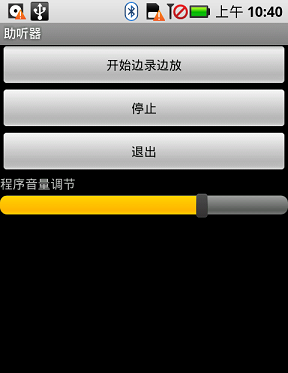Android可以通过MediaRecorder和AudioRecord这两个工具来实现录音,MediaRecorder直接把麦克风的数据存到文件,并且能够直接进行编码(如AMR,MP3等),而AudioRecord则是读取麦克风的音频流。本文使用AudioRecord读取音频流,使用AudioTrack播放音频流,通过“边读边播放”以及增大音量的方式来实现一个简单的助听器程序。
PS:由于目前的Android模拟器还不支持AudioRecord,因此本程序需要编译之后放到真机运行。
先贴出本文程序运行截图:
PS:程序音量调节只是程序内部调节音量而已,要调到最大音量还需要手动设置系统音量。

使用AudioRecord必须要申请许可,在AndroidManifest.xml里面添加这句:
<uses-permission android:name="android.permission.RECORD_AUDIO"></uses-permission>
main.xml的源码如下:
<?xml version="1.0" encoding="utf-8"?> <LinearLayout xmlns:android="http://schemas.android.com/apk/res/android" android:orientation="vertical" android:layout_width="fill_parent" android:layout_height="fill_parent"> <Button android:layout_height="wrap_content" android:id="@+id/btnRecord" android:layout_width="fill_parent" android:text="开始边录边放"></Button> <Button android:layout_height="wrap_content" android:layout_width="fill_parent" android:text="停止" android:id="@+id/btnStop"></Button> <Button android:layout_height="wrap_content" android:id="@+id/btnExit" android:layout_width="fill_parent" android:text="退出"></Button> <TextView android:id="@+id/TextView01" android:layout_height="wrap_content" android:text="程序音量调节" android:layout_width="fill_parent"></TextView> <SeekBar android:layout_height="wrap_content" android:id="@+id/skbVolume" android:layout_width="fill_parent"></SeekBar> </LinearLayout>
testRecord.java的源码如下:
package com.testRecord; import android.app.Activity; import android.media.AudioFormat; import android.media.AudioManager; import android.media.AudioRecord; import android.media.AudioTrack; import android.media.MediaRecorder; import android.os.Bundle; import android.view.View; import android.widget.Button; import android.widget.SeekBar; import android.widget.Toast; public class testRecord extends Activity { /** Called when the activity is first created. */ Button btnRecord, btnStop, btnExit; SeekBar skbVolume;//调节音量 boolean isRecording = false;//是否录放的标记 static final int frequency = 44100; static final int channelConfiguration = AudioFormat.CHANNEL_CONFIGURATION_MONO; static final int audioEncoding = AudioFormat.ENCODING_PCM_16BIT; int recBufSize,playBufSize; AudioRecord audioRecord; AudioTrack audioTrack; @Override public void onCreate(Bundle savedInstanceState) { super.onCreate(savedInstanceState); setContentView(R.layout.main); setTitle("助听器"); recBufSize = AudioRecord.getMinBufferSize(frequency, channelConfiguration, audioEncoding); playBufSize=AudioTrack.getMinBufferSize(frequency, channelConfiguration, audioEncoding); // ----------------------------------------- audioRecord = new AudioRecord(MediaRecorder.AudioSource.MIC, frequency, channelConfiguration, audioEncoding, recBufSize); audioTrack = new AudioTrack(AudioManager.STREAM_MUSIC, frequency, channelConfiguration, audioEncoding, playBufSize, AudioTrack.MODE_STREAM); //------------------------------------------ btnRecord = (Button) this.findViewById(R.id.btnRecord); btnRecord.setOnClickListener(new ClickEvent()); btnStop = (Button) this.findViewById(R.id.btnStop); btnStop.setOnClickListener(new ClickEvent()); btnExit = (Button) this.findViewById(R.id.btnExit); btnExit.setOnClickListener(new ClickEvent()); skbVolume=(SeekBar)this.findViewById(R.id.skbVolume); skbVolume.setMax(100);//音量调节的极限 skbVolume.setProgress(70);//设置seekbar的位置值 audioTrack.setStereoVolume(0.7f, 0.7f);//设置当前音量大小 skbVolume.setOnSeekBarChangeListener(new SeekBar.OnSeekBarChangeListener() { @Override public void onStopTrackingTouch(SeekBar seekBar) { float vol=(float)(seekBar.getProgress())/(float)(seekBar.getMax()); audioTrack.setStereoVolume(vol, vol);//设置音量 } @Override public void onStartTrackingTouch(SeekBar seekBar) { // TODO Auto-generated method stub } @Override public void onProgressChanged(SeekBar seekBar, int progress, boolean fromUser) { // TODO Auto-generated method stub } }); } @Override protected void onDestroy() { super.onDestroy(); android.os.Process.killProcess(android.os.Process.myPid()); } class ClickEvent implements View.OnClickListener { @Override public void onClick(View v) { if (v == btnRecord) { isRecording = true; new RecordPlayThread().start();// 开一条线程边录边放 } else if (v == btnStop) { isRecording = false; } else if (v == btnExit) { isRecording = false; testRecord.this.finish(); } } } class RecordPlayThread extends Thread { public void run() { try { byte[] buffer = new byte[recBufSize]; audioRecord.startRecording();//开始录制 audioTrack.play();//开始播放 while (isRecording) { //从MIC保存数据到缓冲区 int bufferReadResult = audioRecord.read(buffer, 0, recBufSize); byte[] tmpBuf = new byte[bufferReadResult]; System.arraycopy(buffer, 0, tmpBuf, 0, bufferReadResult); //写入数据即播放 audioTrack.write(tmpBuf, 0, tmpBuf.length); } audioTrack.stop(); audioRecord.stop(); } catch (Throwable t) { Toast.makeText(testRecord.this, t.getMessage(), 1000); } } }; }